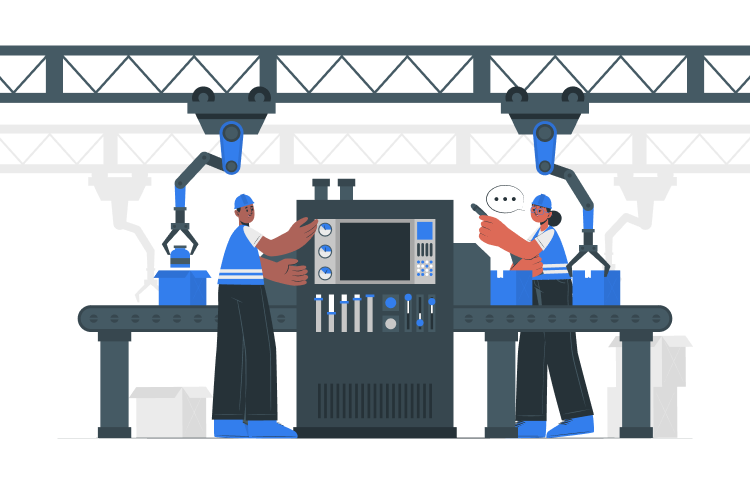Boost OEE Manufacturing: Tips to Improve Effectiveness
Gaurav Singh Rawat
- June 1, 2024
- 7 Min Read

Overall Equipment Effectiveness (OEE) is a key metric used in manufacturing to measure the productivity and efficiency of equipment and processes. It provides a standardized way to quantify how effectively manufacturing time is being utilized. An OEE score of 100% represents perfect production – manufacturing only good parts, as fast as possible, with no downtime.
OEE is important because it helps identify areas of improvement in the manufacturing process. By measuring OEE and analyzing the underlying losses, manufacturers gain valuable insights into how to systematically enhance productivity by reducing equipment-related waste and losses. It is useful both as a benchmark and a baseline – an OEE score can be compared to industry standards and internal targets, while also serving as a starting point to track improvements over time.
What is OEE (Overall Equipment Effectiveness)?
Overall Equipment Effectiveness (OEE) is a comprehensive metric used in manufacturing to measure the efficiency and productivity of equipment. It is a key performance indicator (KPI) that quantifies how well a manufacturing operation is utilized compared to its full potential during the periods when it is scheduled to run. OEE is calculated by multiplying three factors: Availability, Performance, and Quality.
Availability: This measures the percentage of scheduled time that the equipment is available to operate. It accounts for all events that stop planned production for an appreciable length of time, such as equipment breakdowns and changeovers.
Performance: This assesses how well the equipment is performing compared to its maximum potential. It considers factors like equipment speed, minor stops, and idling time.
Quality: This evaluates the rate of production of “good count” products without defects or rework. It takes into account factors such as scrap, reject, and rework.
The formula for calculating OEE is:
OEE = Availability × Performance × Quality
A perfect OEE score of 100% means that only good parts are produced (100% Quality), as fast as possible (100% Performance), with no downtime (100% Availability)

Maximize Your OEE Today
Discover strategies to enhance your Overall Equipment Effectiveness and boost your manufacturing productivity. Start optimizing now!
Benefits of Improving OEE in Manufacturing
Increased Productivity and Output
Improving Overall Equipment Effectiveness (OEE) directly enhances productivity by ensuring that manufacturing equipment operates at its maximum potential.
By identifying and eliminating inefficiencies, manufacturers can increase the output of good quality products within the same time frame. This leads to higher production volumes without the need for additional resources or shifts.
Reduced Costs
Optimizing OEE helps in reducing various costs associated with manufacturing. By minimizing downtime, reducing scrap and rework, and improving the efficiency of equipment, manufacturers can lower their operational expenses.
This includes savings on maintenance, energy consumption, and labor costs. Additionally, better utilization of existing equipment reduces the need for capital investments in new machinery.
Improved Quality
OEE improvement initiatives often lead to better quality control. By focusing on the Quality component of OEE, manufacturers can reduce the number of defective products and rework.
This not only saves costs but also enhances the overall reliability and reputation of the manufacturing process. Consistently producing high-quality products helps in maintaining customer satisfaction and reducing the risk of product recalls.
Better Equipment Utilization
One of the primary goals of OEE is to ensure that equipment is used to its fullest capacity. By tracking and improving Availability, Performance, and Quality, manufacturers can maximize the utilization of their machinery.
This means fewer idle times, optimized production schedules, and better alignment of production capacity with demand. Effective equipment utilization also extends the lifespan of machinery by preventing overuse and ensuring timely maintenance.
Enhanced Competitiveness
In a competitive market, manufacturers need to continuously improve their processes to stay ahead. High OEE scores indicate efficient and effective manufacturing operations, which can be a significant competitive advantage.
By reducing costs, improving quality, and increasing productivity, manufacturers can offer better prices and faster delivery times to their customers. This not only helps in retaining existing customers but also in attracting new ones.

Optimize Production with OEE
Take control of your manufacturing efficiency. Explore methods to increase OEE and achieve operational excellence.
Importance of OEE in Manufacturing
OEE is crucial in manufacturing for several reasons:

Identifying and Reducing Waste
OEE helps manufacturers identify and quantify sources of production losses, such as downtime, speed losses, and quality defects. By addressing these losses, manufacturers can reduce waste and improve overall efficiency.
Improving Productivity
By monitoring OEE, manufacturers can gain insights into how effectively their equipment is being utilized. This allows them to make data-driven decisions to optimize operations, increase throughput, and improve productivity.
Cost Reduction
Improving OEE can lead to significant cost savings. By maximizing the use of existing equipment, manufacturers can avoid the need for additional investments in new machinery, overtime, or outsourcing.
Enhancing Competitiveness
Regular monitoring and improvement of OEE can extend the useful life of equipment by ensuring it is well-maintained and operating efficiently. This reduces the frequency of breakdowns and the need for costly repairs.
Extending Equipment Life
Regular monitoring and improvement of OEE can extend the useful life of equipment by ensuring it is well-maintained and operating efficiently. This reduces the frequency of breakdowns and the need for costly repairs.

Optimize Production with OEE
Take control of your manufacturing efficiency. Explore methods to increase OEE and achieve operational excellence.
Conclusion
Improving Overall Equipment Effectiveness (OEE) is essential for manufacturers aiming to enhance productivity, reduce costs, and maintain a competitive edge.
By focusing on the three key components of OEE—Availability, Performance, and Quality—manufacturers can identify and eliminate inefficiencies in their production processes. Implementing strategies such as Total Productive Maintenance (TPM), optimizing equipment and processes, engaging and training employees, leveraging real-time data and analytics, and setting SMART goals can significantly boost OEE.
Additionally, addressing the Six Big Losses and fostering a culture of continuous improvement are crucial for sustaining high OEE scores. By systematically improving OEE, manufacturers can achieve substantial gains in efficiency and profitability, ensuring long-term success in the market.
Frequently Asked Questions (FAQs)
What is the difference between OEE and Overall Line Efficiency (OLE)?
OEE measures the efficiency of individual pieces of equipment, while Overall Line Efficiency (OLE) measures the efficiency of an entire production line, including the interaction between different machines and processes.
How can OEE be used to improve supply chain efficiency?
By identifying and reducing inefficiencies in production, OEE can help ensure that manufacturing processes are more predictable and reliable, leading to better alignment with supply chain schedules and reduced lead times.
What are the common pitfalls to avoid when implementing OEE?
Common pitfalls include not defining OEE components clearly, averaging OEE values instead of using weighted calculations, and failing to involve all relevant stakeholders in the implementation process.
How does OEE relate to Lean Manufacturing principles?
OEE aligns with Lean Manufacturing by focusing on reducing waste and improving efficiency. Both methodologies aim to optimize production processes and enhance overall productivity.
What is the role of Mean Time Between Failures (MTBF) in OEE?
MTBF is used to measure the reliability of equipment, which directly impacts the Availability component of OEE. Higher MTBF indicates fewer breakdowns and higher equipment availability.
How can bottlenecks affect OEE calculations?
Bottlenecks determine the maximum throughput of a production line. OEE calculations should focus on the bottleneck to identify and address constraints that limit overall efficiency.
What are the best practices for setting OEE targets?
Best practices include setting realistic and achievable targets based on historical data, industry benchmarks, and continuous improvement goals. Targets should be specific, measurable, and aligned with overall business objectives.







